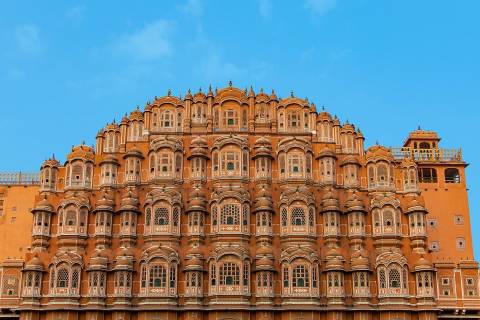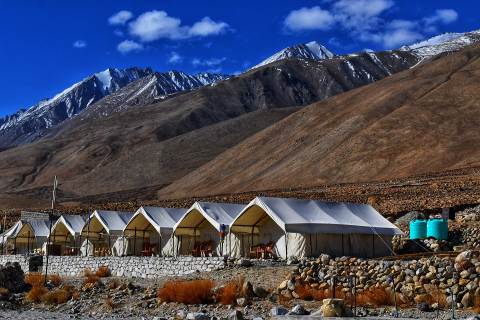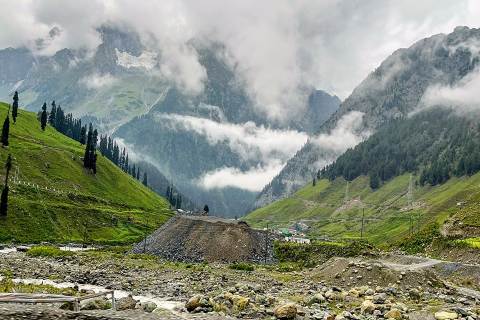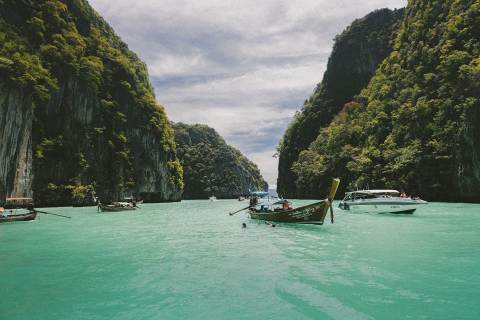Enquire Now

Introduction:
Rajasthan, the land of kings, is a captivating
destination that enchants travelers with its rich history, vibrant culture, and
breathtaking landscapes. From the magnificent palaces and forts to the vast
stretches of desert and wildlife sanctuaries, Rajasthan offers a diverse array
of experiences. In this article, we will take you on a virtual tour of the top
10 must-visit places in Rajasthan, where you can immerse yourself in the royal
heritage, explore ancient architecture, witness the stunning beauty of nature,
and encounter the untamed wildlife. Get ready to be transported to a realm of
enchantment and discover the gems that make Rajasthan a truly extraordinary
destination.
Jaipur:
Jaipur, often referred to as the Pink City,
is the capital of Rajasthan and a city that embodies the grandeur and splendor
of the Rajput era. It is a vibrant blend of history, architecture, and culture,
making it one of the must-visit destinations in Rajasthan.
One of the most iconic attractions in
Jaipur is the Amber Fort. Situated atop a hill, this majestic fort showcases
the fusion of Mughal and Rajput architectural styles. Visitors can explore its
intricate palaces, courtyards, and gardens, and even take an elephant ride to
ascend to the fort.
The City Palace, located in the heart of
Jaipur, is a remarkable complex that showcases a perfect amalgamation of
Rajasthani and Mughal architectural influences. It houses several palaces,
museums, and courtyards, offering visitors a glimpse into the opulent lifestyle
of the royals.
Another architectural marvel in Jaipur is
the Hawa Mahal, also known as the Palace of Winds. This five-story structure
with its intricate latticework windows allowed the women of the royal household
to observe street festivities while maintaining their privacy.
Jaipur is also famous for its bustling
bazaars, where you can indulge in a shopping spree for traditional handicrafts,
textiles, jewelry, and vibrant Rajasthani attire. The Johri Bazaar and Bapu
Bazaar are popular destinations for shopping enthusiasts.
Udaipur:
Udaipur, often called the Venice of the
East or the City of Lakes, is a picturesque destination known for its romantic
ambiance, stunning palaces, and serene lakes. It is considered one of the most
beautiful cities in India.
The City Palace in Udaipur is an
architectural marvel that offers panoramic views of Lake Pichola and the
surrounding landscapes. It is a fusion of Rajasthani, Mughal, European, and
Chinese architectural styles. Inside the palace, visitors can explore its
magnificent courtyards, intricately decorated rooms, and a collection of
artifacts that depict the rich history of the Mewar dynasty.
Lake Pichola is the centerpiece of Udaipur,
and a boat ride on its tranquil waters offers a breathtaking experience. The
lake is adorned with several islands, including Jag Mandir and Jag Niwas (now
the famous Lake Palace hotel). The serene ambiance and the reflection of
palaces and havelis in the lake's crystal-clear waters create a mesmerizing
sight.
Udaipur is also home to several enchanting
temples, such as the Jag Mandir, Jagdish Temple, and Eklingji Temple. These
temples showcase intricate carvings, stunning architecture, and offer spiritual
solace to visitors.
The Saheliyon-ki-Bari, or the Garden of the
Maidens, is a beautiful garden adorned with fountains, kiosks, marble
elephants, and lush greenery. It was built for the royal ladies to relax and
enjoy leisurely walks.
Udaipur is also renowned for its vibrant
art and cultural scene. The Bagore Ki Haveli, now a museum, hosts daily cultural
performances showcasing traditional dance forms, music, and puppet shows.
In conclusion, both Jaipur and Udaipur are
gems of Rajasthan, each offering a unique experience to visitors. While Jaipur
dazzles with its regal forts, palaces, and bustling bazaars, Udaipur enchants
with its romantic lakes, exquisite palaces, and serene temples. Together, they
represent the rich history, architectural marvels, and vibrant culture that
make Rajasthan a truly captivating destination.
Jaisalmer:
Jaisalmer, often referred to as the Golden
City, is a mesmerizing destination located in the heart of the Thar Desert in
Rajasthan. It is renowned for its golden sandstone architecture, vast desert
landscapes, and a rich cultural heritage.
At the heart of Jaisalmer lies the
magnificent Jaisalmer Fort, also known as Sonar Quila or the Golden Fort. This
UNESCO World Heritage Site is a living fort, as it houses shops, homes, and
even hotels within its walls. The intricate carvings, narrow lanes, and
bustling marketplaces within the fort create a unique and enchanting
atmosphere.
One of the highlights of Jaisalmer is the
stunning Havelis, or traditional mansions, adorned with intricate architecture
and delicate carvings. Patwon Ki Haveli, Nathmal Ki Haveli, and Salim Singh Ki
Haveli are among the most prominent ones, showcasing the opulence and
craftsmanship of the bygone era.
Jaisalmer is also known for its camel
safaris, providing visitors with an opportunity to explore the mesmerizing
dunes of the Thar Desert. Riding a camel through the golden sands, watching the
sunset over the desert, and camping under the starry night sky are experiences
that leave a lasting impression.
The Sam Sand Dunes, located just outside
the city, are a popular spot to witness the ethereal beauty of the desert.
Visitors can enjoy thrilling jeep safaris, folk music and dance performances,
and even spend a night in the desert camps, immersing themselves in the rich
cultural heritage of Rajasthan.
Jodhpur:
Jodhpur, often called the Blue City, is a
captivating destination located on the edge of the Thar Desert. It is known for
its vibrant blue-painted houses, magnificent forts, and bustling bazaars.
Mehrangarh Fort, standing majestically atop
a hill, is one of the largest forts in India and offers panoramic views of the
city. It houses several palaces, including the Phool Mahal, Sheesh Mahal, and
Moti Mahal, each adorned with exquisite craftsmanship and intricate detailing.
The museum inside the fort displays a vast collection of artifacts, weapons,
and artwork that provide insights into the history and culture of the region.
The blue-painted houses in the old city,
known as Brahmapuri, create a stunning visual spectacle. Exploring the narrow,
winding lanes of the old city, with glimpses of vibrant colors and intricate
architecture at every turn, is an experience that transports visitors back in
time.
Umaid Bhawan Palace, one of the last great
palaces built in India, is a magnificent blend of Indo-Saracenic and Art Deco
architecture. A part of the palace is now a luxury hotel, while another section
serves as a museum showcasing the history and heritage of the Jodhpur royal
family.
Jodhpur's bustling markets, such as the
Sardar Market and Clock Tower Market, offer a vibrant shopping experience.
Visitors can browse through a variety of handicrafts, textiles, jewelry, and
spices, and indulge in the flavors of Rajasthani cuisine at the local food
stalls.
In conclusion, Jaisalmer and Jodhpur are
two enchanting cities that showcase the rich heritage and architectural
splendor of Rajasthan. Jaisalmer with its golden fort, intricate havelis, and
the mesmerizing Thar Desert, offers a unique experience of desert life.
Jodhpur, with its blue-painted houses, magnificent forts, and bustling markets,
provides a glimpse into the royal grandeur and vibrant culture of Rajasthan.
Together, these cities add to the allure of Rajasthan and leave visitors
captivated with their timeless beauty.
Pushkar:
Pushkar, a sacred town in Rajasthan, is
nestled around the tranquil Pushkar Lake and is considered one of the most
important pilgrimage sites for Hindus. It is known for its spirituality,
vibrant ghats, and the annual Pushkar Camel Fair.
The main attraction in Pushkar is the
Brahma Temple, dedicated to Lord Brahma, the creator in Hindu mythology. It is
one of the few temples in the world dedicated to Lord Brahma and draws devotees
and tourists alike. The temple showcases stunning architecture and intricate
carvings, creating a serene and peaceful ambiance.
Pushkar Lake holds immense religious
significance and is believed to be formed by a lotus flower dropped by Lord
Brahma. Pilgrims visit the lake to take holy dips in its waters, which are
believed to cleanse sins and provide spiritual purification. The lake is also
dotted with numerous ghats, where devotees perform religious rituals and
ceremonies.
One of the major attractions in Pushkar is
the annual Pushkar Camel Fair, a vibrant and colorful event that attracts
travelers from around the world. The fair features camel races, livestock
trading, cultural performances, and folk music. It offers a unique opportunity
to witness the rich cultural heritage of Rajasthan and experience the
traditional rural lifestyle.
Apart from the religious and cultural
significance, Pushkar also offers a bohemian atmosphere with its bustling
streets filled with cafes, handicraft shops, and yoga centers. Visitors can
immerse themselves in the spiritual vibes, enjoy local Rajasthani cuisine, shop
for traditional artifacts and clothing, or even participate in yoga and
meditation retreats.
Ranthambore:
Ranthambore National Park, located in the
Sawai Madhopur district of Rajasthan, is one of the most renowned wildlife
destinations in India. It is a fascinating blend of wildlife conservation,
historical heritage, and natural beauty.
The park is famous for its population of
tigers and is considered one of the best places in India to spot these
magnificent creatures in their natural habitat. Jeep and canter safaris are
popular ways to explore the park and increase the chances of tiger sightings.
Apart from tigers, Ranthambore is also home to a wide variety of wildlife,
including leopards, sloth bears, striped hyenas, and various species of deer
and birds.
Ranthambore Fort, a UNESCO World Heritage
Site, is another major attraction within the national park. It is perched atop
a hill and offers panoramic views of the surrounding landscape. The fort
showcases impressive architecture, ancient temples, and historical ruins that
provide insights into the region's rich past.
The park's diverse topography, which
includes lakes, rocky hills, and dense forests, adds to its allure and creates
a favorable habitat for wildlife. The picturesque lakes, such as Padam Talao
and Malik Talao, are popular spots for birdwatching and wildlife sightings.
In addition to wildlife safaris, visitors
to Ranthambore can also explore the nearby villages and interact with the local
communities, experiencing the rural lifestyle and culture of Rajasthan
firsthand.
Ranthambore National Park provides a unique
opportunity to witness the raw beauty of nature, encounter wildlife up close,
and delve into the historical grandeur of the region. It is a haven for
wildlife enthusiasts, nature lovers, and photographers seeking to capture the
essence of Rajasthan's wildlife and natural landscapes.
Ajmer:
Ajmer, located in the Ajmer district of
Rajasthan, is a city with a rich historical and cultural heritage. It is
renowned for its religious significance and is home to several prominent
attractions, including the Ajmer Sharif Dargah and the Adhai Din Ka Jhonpra.
The Ajmer Sharif Dargah is one of the most
important Sufi shrines in India. It is the tomb of the Sufi saint Khwaja
Moinuddin Chishti and attracts millions of devotees from different faiths. The
Dargah complex is a beautiful example of Indo-Islamic architecture, with a
massive gateway, marble courtyards, and a domed tomb. The atmosphere here is
filled with spirituality, and visitors can witness qawwali (devotional music)
sessions that take place daily.
Adhai Din Ka Jhonpra is an ancient mosque
located on the outskirts of Ajmer. Its name translates to "two and a half
days" and refers to a legend that claims the mosque was constructed in
just two and a half days. The mosque showcases Indo-Islamic architecture with
intricate stone carvings and delicate screens. It is a significant historical
site that reflects the architectural grandeur of the region.
Another notable attraction in Ajmer is the
beautiful Ana Sagar Lake. Built by Anaji Chauhan, the grandfather of Prithviraj
Chauhan, it is an artificial lake that offers a serene environment and
panoramic views of the surrounding hills. Boating facilities are available,
allowing visitors to enjoy the tranquility of the lake.
Ajmer also has a rich Rajput heritage, and
the Taragarh Fort stands as a testament to this. Perched on a hilltop, the fort
offers splendid views of the city. It has several structures within its
complex, including the Bhim Burj, a cannon used during battles, and the Miran
Saheb ki Dargah, a memorial dedicated to a loyal soldier.
Bikaner:
Bikaner, situated in the northwest part of
Rajasthan, is a vibrant city known for its magnificent palaces, forts, and
well-preserved heritage. It was founded by Rao Bika in the 15th century and is
often referred to as the "Camel Country" due to its rich association
with camel breeding and trading.
The Junagarh Fort is the crown jewel of
Bikaner and a must-visit attraction. Built in the 16th century, the fort is an
architectural marvel that combines the grandeur of Rajput, Mughal, and Gujarati
styles. It houses several palaces, temples, and pavilions adorned with
intricate carvings, frescoes, and mirror work. The Anup Mahal, Ganga Niwas, and
Chandra Mahal are some of the prominent structures within the fort complex.
The Lalgarh Palace is another architectural
gem in Bikaner. Constructed in red sandstone, it was built by Maharaja Ganga
Singh in the early 20th century. The palace is a blend of Rajput, Mughal, and
European architectural styles and now serves as a heritage hotel. It boasts
magnificent courtyards, stunning interiors, and an extensive collection of artifacts
and artwork.
Bikaner is also famous for its havelis,
traditional mansions showcasing exquisite craftsmanship. The Rampuria Havelis,
built by the wealthy Rampuria family, are a prime example. These havelis
feature intricately carved facades, jharokhas (balconies), and ornate frescoes
depicting mythological scenes and historical events.
Mount Abu:
Mount Abu is a picturesque hill station
located in the Aravalli Range in the Sirohi district of Rajasthan. It is the
only hill station in the state and offers a refreshing escape from the
scorching desert heat. Known for its pleasant climate, lush green landscapes,
and serene lakes, Mount Abu is a popular tourist destination.
One of the main attractions in Mount Abu is
the Dilwara Temples. These exquisite Jain temples are renowned for their
architectural brilliance and intricate marble carvings. The temples date back
to the 11th and 13th centuries and showcase exceptional craftsmanship. The
intricate detailing, delicate sculptures, and the use of white marble make the
temples a visual treat for visitors.
The Nakki Lake is another major attraction
in Mount Abu. Surrounded by hills and lush greenery, the lake is believed to be
sacred and has a mythological significance. Visitors can enjoy boating in the
lake or take a leisurely stroll along the promenade, enjoying the serene
atmosphere and picturesque views.
To witness the mesmerizing sunset and
panoramic views of the surrounding landscapes, visitors can head to the Sunset
Point and Honeymoon Point. These viewpoints offer breathtaking vistas of the
hills, valleys, and the golden-hued sunset, providing a perfect backdrop for
photography enthusiasts.
Mount Abu is also home to the Achalgarh
Fort, a historical monument that dates back to the 14th century. The fort is
perched on top of a hill and offers panoramic views of the Aravalli Range.
Inside the fort, visitors can explore the ancient Achaleshwar Mahadev Temple
and the famous Kantinath Jain Temple.
For nature enthusiasts, the Guru Shikhar
Peak is a must-visit spot. It is the highest peak in the Aravalli Range and
offers stunning views of the surrounding hills and valleys. Visitors can reach
the peak by trekking or by taking a drive through the scenic winding roads.
Chittorgarh:
Chittorgarh, located in the southern part
of Rajasthan, is a city steeped in history and valor. It is known for its
magnificent Chittorgarh Fort, which stands as a testament to the bravery and
sacrifice of the Rajput warriors.
The Chittorgarh Fort is the largest fort in
India and a UNESCO World Heritage Site. Spread over a vast area, it encompasses
palaces, temples, towers, and reservoirs. The fort is famous for its seven
grand gates, including the impressive Vijay Stambh (Tower of Victory) and Kirti
Stambh (Tower of Fame). These towers showcase intricate carvings, architectural
finesse, and are symbolic of the Rajput valor.
Within the fort, visitors can explore
several notable structures, such as the Rana Kumbha Palace, Padmini Palace, and
Meera Temple. The Rana Kumbha Palace is known for its architectural grandeur
and historical significance. The Padmini Palace is associated with the
legendary Queen Padmini and offers panoramic views of the surrounding
landscape. The Meera Temple is dedicated to the poet-saint Meera Bai and is a
revered pilgrimage site for her followers.
The Vijay Stambh (Tower of Victory) is one
of the iconic landmarks of Chittorgarh. Built by Maharana Kumbha to commemorate
his victory over the forces of Malwa and Gujarat, the tower is adorned with
intricate carvings depicting scenes from Hindu mythology and the valor of the
Rajput warriors.
Chittorgarh is also known for its
magnificent temples. The Kalika Mata Temple, the Kumbha Shyam Temple, and the
Sammidheshwara Temple are among the prominent ones. These temples exhibit
splendid architecture and are considered sacred by devotees.
Conclusion:
Rajasthan truly stands as a treasure trove
of wonders, offering a blend of history, culture, and natural beauty that
captivates the hearts of visitors. From the royal splendor of Jaipur and
Udaipur to the golden sands of Jaisalmer and the wilderness of Ranthambore,
each destination in Rajasthan has its own allure and leaves an indelible
impression on those who venture here. Whether you seek architectural marvels,
spiritual serenity, or thrilling wildlife encounters, Rajasthan's top 10
must-visit places have something to offer every traveler. Embark on a journey
to this majestic state, where the tales of valor and grandeur echo through the
ancient walls and the essence of royalty lingers in the air. Rajasthan awaits,
ready to weave its magic and create unforgettable memories that will last a
lifetime.








